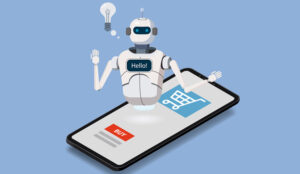Elizabeth Tobey at NICE looks beyond the chatbot and explains what it really means to put AI to work for better CX.
ChatGPT is in, chatbots are out. That’s the word on the street.
But before we relegate chatbots to the annals of history, it’s important to understand the full range of this conversational technology and the tools that make it possible.
By digging into chatbots’ capabilities, limitations, and prime use cases, we’re able to determine how to best apply chatbot and AI technologies to create exceptional CX.
Generative AI – the kind of technology that underpins ChatGPT – is revolutionary. It will fundamentally transform how we interact with data on all fronts.
With a constructive, pre-trained transformer, we are now able to create new and unique, coherent sentences to answer specific questions (or “prompts,” as they are generally known). For agents, employees, and consumers on a CX journey, this is incredible.
Generative AI can circumvent much of the searching, waiting, and incomplete answers that so often plague us, whether we’re interacting with an agent in real-time or a self-service solution.
But generative AI alone is not a silver bullet. GPT technology is semantically advanced, meaning that it creates fluent, defensible statements – but the accuracy and relevance of those statements to the situation at hand may not always hit the mark.
Solutions using generative AI, simply put, need guardrails. To be useful and trustworthy, they need to be trained on a brand’s specific data (what customer interactions are most successful, for example) and tuned into the brand’s constitution.
AI needs to be able to answer questions accurately every time, and not say things that are out of scope of the brand’s guidelines, or irrelevant to their products and services.
By contrast, traditional chatbots, as we know them, are closely brand-aligned, and they do not have the semantic capacity of generative AI.
With pre-defined journeys that respond to a finite set of inputs, resulting in a narrow and rigid set of outputs, chatbots are tailored to guide specific journeys.
The issue with this is that they quickly become too narrow and rigid. There is little chance one individual would input exactly the same query to a chatbot as another.
There are dozens or hundreds of ways to ask even a simple question, present a problem, or reply to a prompt from a bot – but the bot, with its human-designed journeys, is limited in its comprehension and versatility. This is the root of what makes us dread bot interactions: communication limitations.
By bringing generative AI into the picture, we solve for this massive communication issue. Using large language models, we now can equip bots with deeper comprehension, no matter how a sentence is phrased, and the ability to follow an interaction over time.
This exceptional semantic breakthrough – for bots to understand intent and converse like a human – unlocks the ability for us to have successful and efficient conversations with bots to resolve any issue that might be thrown our way.
And by adding in data from brand-specific interactions, from the agent, employee, and customer perspectives, we are able to train AI to only interact with brand-specific conversations and react within brand guidelines.
The ability to do both of these things (engage in generative AI conversations that have phenomenal semantic understanding and train AI on brand-specific data) separately has been within our reach for a while now, but the ability to pair these powerful technologies together has not been fully realized until recently.
With AI models trained on brand-specific data and tuned specifically for optimal CX interactions, combined with generative AI that can continuously learn, support multiple languages, understand intent, and create trustworthy, coherent sentences from massive amounts of unstructured data – we can make chatbots significantly more practical and far more pleasant.
Bottom line? We’re primed to embrace chatbots because, with generative AI, they can finally be what we always wanted: a conversational self-service portal that will help us obtain information we need, delivered accurately and presented in our preferred format.
This blog post has been re-published by kind permission of NiCE-ltd – View the Original Article
For more information about NiCE-ltd - visit the NiCE-ltd Website
Call Centre Helper is not responsible for the content of these guest blog posts. The opinions expressed in this article are those of the author, and do not necessarily reflect those of Call Centre Helper.
Author: NiCE-ltd
Published On: 30th May 2023
Read more about - Guest Blogs, NiCE






 NiCE (NASDAQ: NICE) is transforming the world with AI that puts people first. Our purpose-built AI-powered platforms automate engagements into proactive, safe, intelligent actions, empowering individuals and organizations to innovate and act, from interaction to resolution. Trusted by organizations throughout 150+ countries worldwide, NiCE’s platforms are widely adopted across industries connecting people, systems, and workflows to work smarter at scale, elevating performance across the organization, delivering proven measurable outcomes.
NiCE (NASDAQ: NICE) is transforming the world with AI that puts people first. Our purpose-built AI-powered platforms automate engagements into proactive, safe, intelligent actions, empowering individuals and organizations to innovate and act, from interaction to resolution. Trusted by organizations throughout 150+ countries worldwide, NiCE’s platforms are widely adopted across industries connecting people, systems, and workflows to work smarter at scale, elevating performance across the organization, delivering proven measurable outcomes. 









